Gerrit Thomas Rietveld Maquette, for the 'Danish' chair circa 1950-1956 Cardboard. 3.1 x 2.5 x 3.7 cm (1 1/4 x 0 7/8 x 1 1/2 in.)
Provenance Johan van Tricht, Holland Mr Vloemans of Vloemans Antiquarian Books, the Hague, Holland Literature Rob Dettingmeijer, Marie-Thérèse van Thoor, Ida van Zijl eds., Rietvelds Universum, Rotterdam 2010, p. 158, for the photograph of the 1956 maquette in the collection of the Centraal Museum Catalogue Essay In the years directly after World War II, Gerrit Rietveld was looking for new challenges. In 1946 he participated in an exhibition on contemporary applied arts in the Amsterdam Stedelijk Museum with his aluminium chair of 1942 and a small chair composed of bent triplex segments. It has been suggested that this last chair, which was never illustrated, might have been an early version of the chair which became known as the ‘Danish’ chair after Rietveld showed it at an exhibition on Dutch design in Denmark in 1952. Several (undated) examples of the Danish chair are known with small differences in execution and colour. The Utrecht Centraal Museum owns a version in fibre and recently acquired a metal version which might have served as a prototype for the versions in triplex and fibre. Of this metal prototype, dated 1950 by Gerard van de Groenekan a design drawing is known with an annotation 'Tomado 1952'. This would confirm Han Schröder's (daughter of Truus Schröder) later claim that the Danish chair was originally designed by Rietveld for Tomado, a Dutch manufacturer of household ironware. However, the Danish chair was never produced by Tomado and it disappeared from view after the 1952 exhibition, to resurface in 1956 in Rietveld's maquette for a presentation at the 1958 Brussels World Expo , entitled ‘The Ideal Flat’. A contemporary photograph of the maquette shows two paper scale model Danish chairs identical to the one here offered, combined with scale models of zig zag chairs and easy chairs with angular armrests. At the final presentation in 1958 however, the Danish chairs were nowhere to be seen. Instead, Rietveld showed two types of upholstered easy chairs manufactured by Artifort as well as the ‘Mondial’ chair manufactured by Gispen. It is possible that the scale model here offered was once part of the 1956 maquette for the Brussels World Fair. This would arguably make it one of the few postwar pieces made by Rietveld in person, since by then only models and prototypes were executed by the master himself. Rob Driessen, Amsterdam. Read More Artist Bio Gerrit Thomas Rietveld Dutch • 1888 - 1964 Gerrit Thomas Rietveld began as an apprentice in his father's cabinetmaking workshop, going on to train and work as a draftsman. In 1917 he started his own furniture-making workshop in Utrecht. Positive critical review by Theo van Doesburg in his journal De Stijl resulted in near-instantaneous influence on broader developments in European modernism. This connection to the De Stijl movement also inspired him to introduce color to the posts, rails and terminals of his furniture. His resulting "Red-blue" armchair is among the most iconic chair designs of the twentieth century. From the beginning, Rietveld embraced modernist principles of functionalism, simplicity of form and mass-production, and eventually moved away from De Stijl to become a member of the Congrès Internationaux d'Architecture Moderne (CIAM). Rietveld worked through the post-war years, completing a number of private residences, housing developments and institutions. He continued to design furniture for these commissions as well as for retailers like Metz & Co. View More Works
Gerrit Thomas Rietveld Maquette, for the 'Danish' chair circa 1950-1956 Cardboard. 3.1 x 2.5 x 3.7 cm (1 1/4 x 0 7/8 x 1 1/2 in.)
Provenance Johan van Tricht, Holland Mr Vloemans of Vloemans Antiquarian Books, the Hague, Holland Literature Rob Dettingmeijer, Marie-Thérèse van Thoor, Ida van Zijl eds., Rietvelds Universum, Rotterdam 2010, p. 158, for the photograph of the 1956 maquette in the collection of the Centraal Museum Catalogue Essay In the years directly after World War II, Gerrit Rietveld was looking for new challenges. In 1946 he participated in an exhibition on contemporary applied arts in the Amsterdam Stedelijk Museum with his aluminium chair of 1942 and a small chair composed of bent triplex segments. It has been suggested that this last chair, which was never illustrated, might have been an early version of the chair which became known as the ‘Danish’ chair after Rietveld showed it at an exhibition on Dutch design in Denmark in 1952. Several (undated) examples of the Danish chair are known with small differences in execution and colour. The Utrecht Centraal Museum owns a version in fibre and recently acquired a metal version which might have served as a prototype for the versions in triplex and fibre. Of this metal prototype, dated 1950 by Gerard van de Groenekan a design drawing is known with an annotation 'Tomado 1952'. This would confirm Han Schröder's (daughter of Truus Schröder) later claim that the Danish chair was originally designed by Rietveld for Tomado, a Dutch manufacturer of household ironware. However, the Danish chair was never produced by Tomado and it disappeared from view after the 1952 exhibition, to resurface in 1956 in Rietveld's maquette for a presentation at the 1958 Brussels World Expo , entitled ‘The Ideal Flat’. A contemporary photograph of the maquette shows two paper scale model Danish chairs identical to the one here offered, combined with scale models of zig zag chairs and easy chairs with angular armrests. At the final presentation in 1958 however, the Danish chairs were nowhere to be seen. Instead, Rietveld showed two types of upholstered easy chairs manufactured by Artifort as well as the ‘Mondial’ chair manufactured by Gispen. It is possible that the scale model here offered was once part of the 1956 maquette for the Brussels World Fair. This would arguably make it one of the few postwar pieces made by Rietveld in person, since by then only models and prototypes were executed by the master himself. Rob Driessen, Amsterdam. Read More Artist Bio Gerrit Thomas Rietveld Dutch • 1888 - 1964 Gerrit Thomas Rietveld began as an apprentice in his father's cabinetmaking workshop, going on to train and work as a draftsman. In 1917 he started his own furniture-making workshop in Utrecht. Positive critical review by Theo van Doesburg in his journal De Stijl resulted in near-instantaneous influence on broader developments in European modernism. This connection to the De Stijl movement also inspired him to introduce color to the posts, rails and terminals of his furniture. His resulting "Red-blue" armchair is among the most iconic chair designs of the twentieth century. From the beginning, Rietveld embraced modernist principles of functionalism, simplicity of form and mass-production, and eventually moved away from De Stijl to become a member of the Congrès Internationaux d'Architecture Moderne (CIAM). Rietveld worked through the post-war years, completing a number of private residences, housing developments and institutions. He continued to design furniture for these commissions as well as for retailers like Metz & Co. View More Works
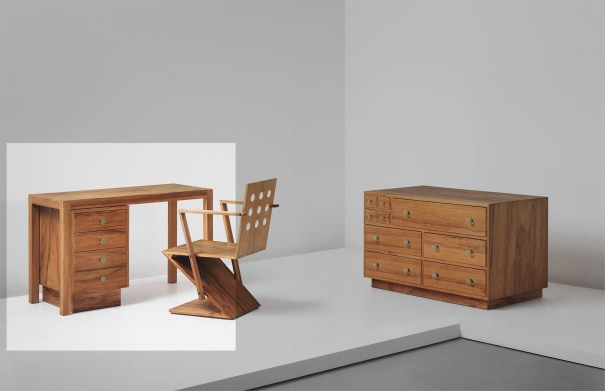

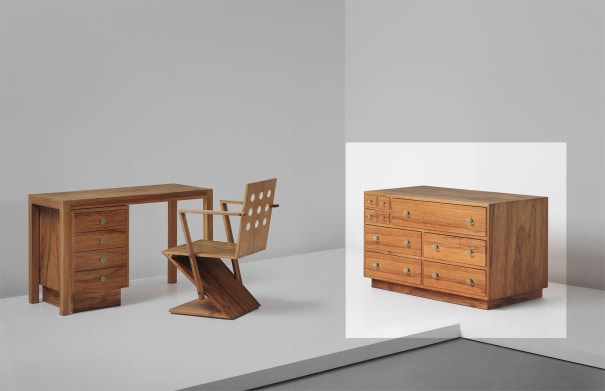
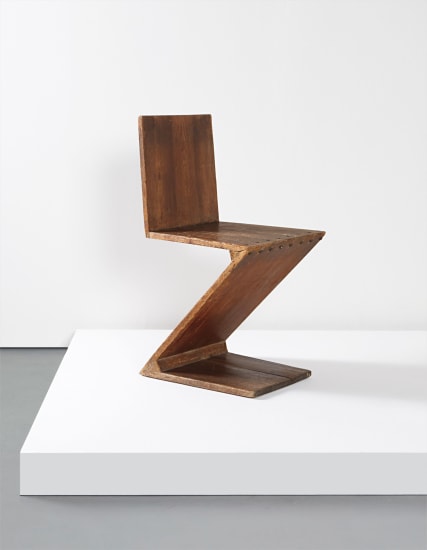
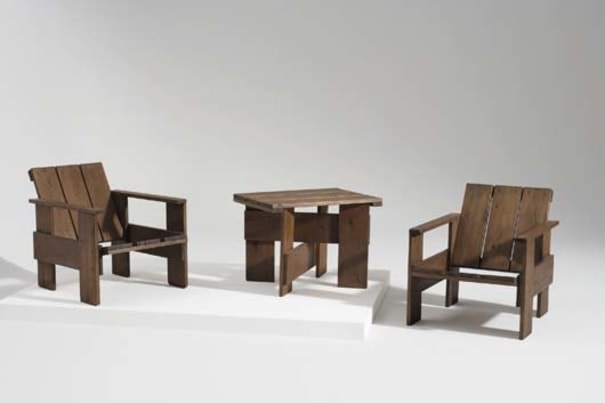

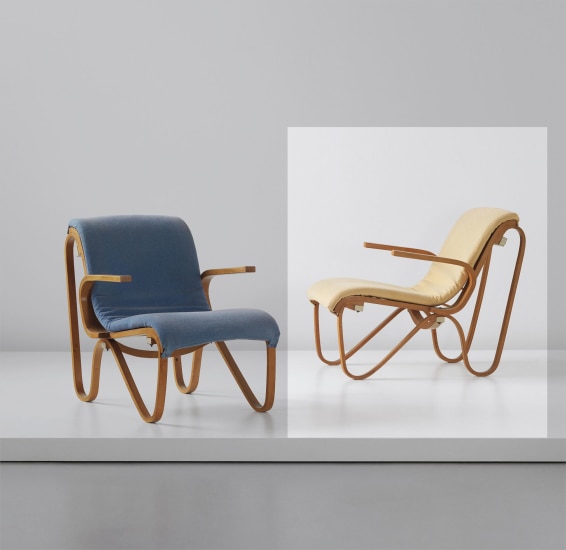

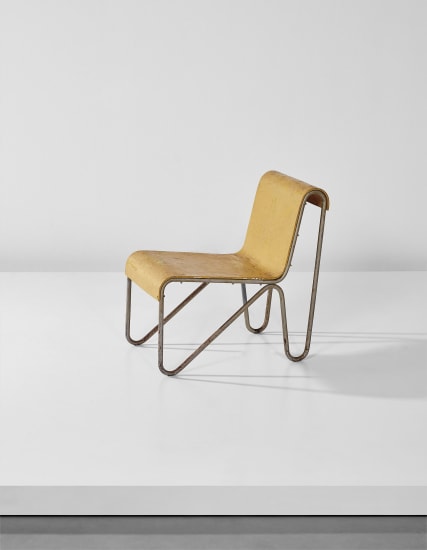
Testen Sie LotSearch und seine Premium-Features 7 Tage - ohne Kosten!
Lassen Sie sich automatisch über neue Objekte in kommenden Auktionen benachrichtigen.
Suchauftrag anlegen